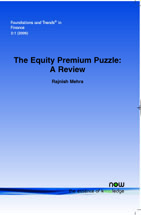The Equity Premium Puzzle: A Review
By Rajnish Mehra, Department of Economics, University of California and NBER, mehra@econ.ucsb.edu
Abstract
Over two decades ago, Mehra and Prescott (1985) challenged the finance profession with a poser: the historical US equity premium is an order of magnitude greater than can be rationalized in the context of the standard neoclassical paradigm of financial economics. This regularity, dubbed "the equity premium puzzle," has spawned a plethora of research efforts to explain it away. In this review, the author takes a retrospective look at the original paper and explains the conclusion that the equity premium is not a premium for bearing non-diversifiable risk.
The Equity Premium Puzzle
The Equity Premium Puzzle reviews the literature on this phenomenon from the original papers by Mehra and Prescott to the present. The author shows that the equity premium – the return earned by a broad market index in excess of that earned by a relatively risk-free security – is not a premium for bearing non-diversifiable risk. The Equity Premium Puzzle documents the historical equity premium in the United States and in selected countries with significant capital markets, examines the question, 'Is the equity premium a premium for bearing non-diversifiable risk?', addresses risk and preference based explanations of the equity premium, and reviews the nascent literature that takes as given the findings in Mehra and Prescott (1985) and tries to account for the equity premium by factors other than aggregate risk. The Equity Premium Puzzle offers a birds-eye view of the literature explained by one of the authors of the pioneering work in this area. This is must reading for all students and scholars of finance and macroeconomics.
